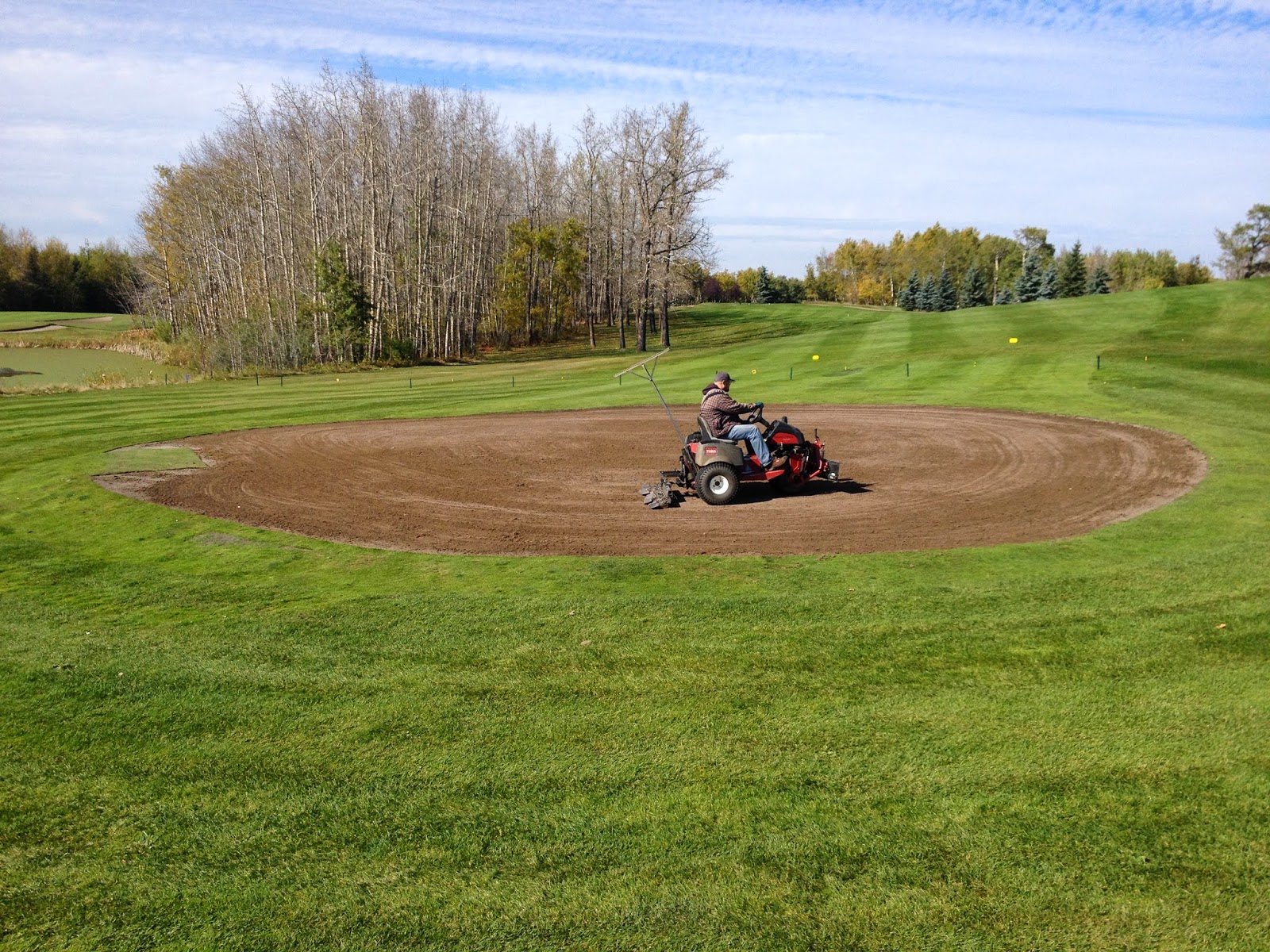Spring 2015
As you may see #7 Green has overwintered well and is on its way to a healthy stand of turf and great playing surface. It is crucial that we manage this green properly by doing all possible "cultural practices" and "BMP's" involved in making this green as good as possible. Patience is a virtue when it comes this, as it is important that the turfgrass establishes itself so all players get the best possible playing conditions for a long time to come.
 |
| After first mow, topdress and brush |
 |
| Second cut with the walker mower and sufficient watering techniques, #7 newly re-surfaced green is coming along right on schedule |
Fall 2014
After some tested trials, number crunching and the complications with the health of #7 green, us managers and crew members made a decision to re-surface it with the turf from our Creeping bentgrass nursery
 |
| Strip sod from our in-house nursery |
 |
| Strip all sod off the entire #7 green |
 |
| Very labour intensive job for the crew |
 |
| Turf is all stripped off and ready for re-surfacng |
 |
| It is important to get rid of all imperfections and make sure the topsoil is properly prepped for new sod to be layed |
 |
| Specialized turf equipment is used to do these tasks |
 |
| Re-surfacing is a tedious process to make sure all seams are staggered and fit togther precisely |
 |
| Cultural and BMPs are used to ensure that the turf establishes a healthy stand come spring time |
 |
| Final product after topdressing sand is brushed and irrigated in. Fingers crossed that mother nature is kind to us and that this green overwinters well throughout the long winter months |
Test area for future re-surfacing projects. #7 will most likely be the first candidate so we elected to use this GRN for our trial.
 |
| Cut sod from our nursery |
 |
| Lay Sod on desired area (#7 GRN) |
 |
Apply starter fertilizer to newly sodded area
|
 |
| Proper BMP & Cultural Practices are applied to ensure sod is established quickly and provide best quality possible |
Spring 2014
Due to another and even harsher winter than the previous one, certain turfed areas on the course are taking a little longer than usual to recover. With the heavy snow, long duration and freeze/thaw conditions throughout the winter and spring months, weaker grass species & cultivars such as Annual bluegrass Poa Annua were not able to survive. Therefore leaving dead spots in highly playable areas (greens and tees). As we are still in the growing part of the season the maintenance team is taking matters into their own hands and repairing these imperfections to provide the best playing conditions possible.
 |
| Plugs were taken out of the Bentgrass nursery and placed on the playing greens |
 |
| After healthy plugs were put into place we put down some BG seed to ensure regrowth |
 |
| Mini spike & seed is a common practice at this time of the year to fill in weak spots and allow grass to knit together |
 |
| Solid tine aeration on greens to allow for better air and gas exchange. By performing this practice it helps with plant health and has minimal disruption to play |
 |
| We like to show our professionalism by having clean equipment |
 |
Making sure course accessories are ready to go

Clearing paths so we can navigate around the course

 |
 |
| Pushing snow to initiate faster melt |
 |
Greens appear to have overwintered well. As the turf is becoming exposed and free of snow cover, air flow and sunlight is a good thing. The process of photosynthesis can occur and help produce carbohydrates within the plant which will strengthen the stand. As the turf is coming out of dormancy and carbohydrate reserves are depleting, it is important we do whatever we can to relieve entities that cause stress on the plant. Especially this time of the year where the plant is vulnerable, receptive to disease and other elements such as spring weather. Air flow will draw oxygen to the plant and help dry things up. This also helps reduce disease pressure, warming of soil temperatures and brings life back into the grass.
|
 |
| Pumping water is key at this time of the year, where run off is moving rapidly |
 |
| Although most of the snow is gone, the course is very wet. It is important to pump off standing water to speed up drying |
 |
| Soil temperatures are taken early in the season to give indication and time frames for plant growth and microbial activity |
 |
| Crew brushing GRN's |
 |
Brushing greens not only helps move topdressing sand into fall core aeration holes but it also improves mowing quality. By standing up the non vertical stolons (roots) and leaf blades of the bentgrass & annual bluegrass species used on our greens, the mower blades are able to produce a good cut therefore a more consistent putting surface.
|
%E2%80%8F.jpg) |
| Starting to verticutt areas on the course. This practice helps control the grain of the grass but its main purpose is for dethatching. By removing the thatch layer between the leaves and the root system it improves gas exchange and water infiltration. This in turn will make for a thicker and denser turf. |
 |
| After verticutting is finished, the blower is used to remove debris from that area and mowers can then come on |








































%E2%80%8F.jpg)
No comments:
Post a Comment